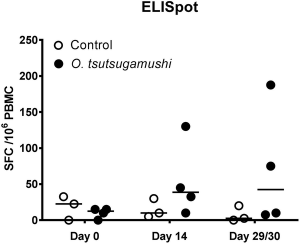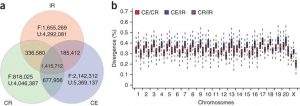Bottom
Scrub typhus is a major endemic disease in tropical Asia caused by Orientia tsutsugamushi for which an effective, broadly protective vaccine is not available. Successful evaluation of candidate vaccines requires well-characterized animal models and a better understanding of the immune response against O. tsutsugamushi. While many animal species have been used to study host immunity and vaccine responses in scrub typhus, only limited data exist in non-human primate (NHP) models.
Findings of methodology/principles
In this study, we evaluated an NHP scrub typhus disease model based on intradermal inoculation of the Karp strain of O. tsutsugamushi in Macaca mulatta Recombinant (n = 7). After intradermal inoculation with 106 murine LD50 of O. tsutsugamushi in the anterior thigh (n = 4) or mock inoculum (n = 3), a series of chronological investigations including haematological, biochemical, molecular and molecular assays were performed. immunological, until day 28, when tissues were collected for pathology and immunohistochemistry.
In all NHP inoculated with O. tsutsugamushi, but not sham inoculated, the development of a classic eschar with central necrosis, regional lymphadenopathy, and elevated body temperature was observed on days 7 to 21 post-inoculation (pi). ; bacteremia was detected by qPCR on days 6-18 pi; and impaired liver enzyme function and increased white blood cells on day 14 pi. Immunological assays demonstrated elevated serum levels of soluble cell adhesion molecules, anti-O. Tsutsugamushi-specific antibody responses (IgM and IgG) and pathogen-specific cell-mediated immune responses in inoculated macaques. qPCR assays detected O. tsutsugamushi in eschar, spleen, draining and non-draining lymph nodes, and double immunostaining demonstrated intracellular O. tsutsugamushi in eschar and lymph node antigen-presenting cells.
Product name
(Macaca Rhesus) Odontogenic Ameloblast Associated Protein (ODAM), Recombinant Protein
Full product name
Recombinant Macaca mulatta (Rhesus Macaque) Odontogenic Ameloblast Associated Protein (ODAM)
Product Synonym Names
Recombinant odontogenic ameloblast associated protein (ODAM) (Rhesus macaque); Odontogenic ameloblast associated protein; apin
Product gene name
ODAM Recombinant Protein

Product Synonym Gene Name
ODAM; APIN
For research use only
For research use only. It should not be used in diagnostic procedures.
Chromosome location
chromosome: 5; NC_007862.1 (59476282..59484317, plugin). Location: Chromosome: 5
3D structure: ModBase 3D structure for A1YQ92
Host: E Coli or Yeast or Baculovirus or Mammalian Cell
Purity/Purification
Greater than or equal to 85% purity as determined by SDS-PAGE. (lot specific)
Form/Format
Lyophilized or liquid (Format to be determined during the manufacturing process)
Label information
This protein contains an N-terminal tag and may also contain a C-terminal tag. The types of tags are determined by several factors, including the stability of the tagged protein; ask for information about the labels.

Sterility: Sterile filter available on request.
Endotoxin: Low endotoxin available on request.
Species: Mulatto macaque (Rhesus macaque)
Preparation and Storage
Store at -20 degrees C. For long-term storage, store at -20 or -80 degrees C.
ISO certification
Manufactured in an ISO 9001:2015 certified laboratory.
Other notes
On occasion, small volumes of ODAM recombinant protein vials may become trapped in the product vial seal during shipping and storage. If necessary, briefly spin the vial in a tabletop centrifuge to dislodge any liquid in the vial cap. Certain products may require dry ice shipping and an additional dry ice fee may apply.
Precautions
All MyBioSource products are for scientific laboratory research purposes and not for diagnostic, therapeutic, prophylactic, or in vivo use. Through your purchase, you expressly represent and warrant to MyBioSource that you will properly test and use any Product purchased from MyBioSource in accordance with industry standards. MyBioSource and its authorized distributors reserve the right to refuse to process any order where we reasonably believe the intended use will not meet our acceptable guidelines.
Disclaimer
While every effort has been made to ensure the accuracy of the information provided in this datasheet, MyBioSource shall not be responsible for any omissions or errors contained in this document. MyBioSource reserves the right to make changes to this datasheet at any time without notice.
Conclusions/Importance
These data show the potential of using rhesus macaques as a model of scrub typhus, for the evaluation of correlates of protection in both natural and vaccine-induced immunity and support the evaluation of future candidate bush typhus vaccines.

